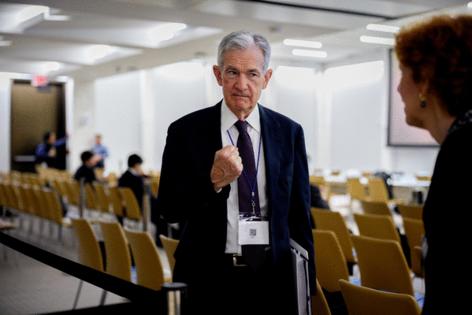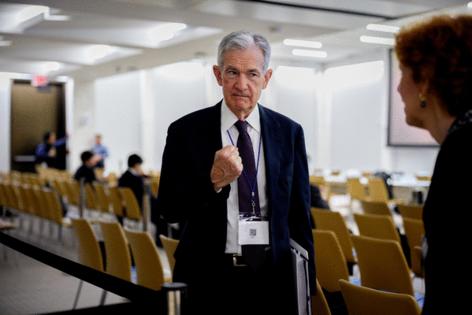Commentary: The Federal Reserve's century-long power grab
Published in Op Eds
In 1913, Congress gave the Federal Reserve a clear and narrow mission: Safeguard the value of our money and support stable employment. More than a century later, the Fed has mutated into a sprawling political empire — so bloated that it spends $7 billion a year and employs almost 24,000 people and still managed to lose $114 billion of taxpayer value in 2023.
Many of its top officials cling to the notion that the Fed must exist in a vacuum — immune from oversight — because of a twisted belief that “independence” justifies unaccountable power. No one should buy that argument.
The truth is simple: The Fed, like the U.S. Department of Education, United States Agency for International Development and so many other agencies that have come under attack by President Donald Trump’s administration, has strayed far from its original purpose. In the Fed’s case, it has evolved from an agency that was created to serve as a disciplined independent monetary steward into a super agency that’s engaged in politics, social policy and even climate activism.
In 1977, Congress amended the Federal Reserve Act, formally requiring the Fed to pursue “maximum employment, stable prices and moderate long-term interest rates.” On paper, this looked balanced. In practice, it opened the door to subjective trade-offs and political spin. That ambiguity gave the Fed cover to dive into broader economic and even social policy debates — planting the seeds for the scope creep that would later explode.
In 2009, the Fed expanded power after a crisis it should have prevented. The 2008 financial crisis should have led to a reckoning for the Fed, which ignored mounting leverage, weak underwriting and dangerous risk concentrations. Instead, it was rewarded with more authority. Between 2008 and 2013, more than 500 banks failed, devastating community lenders. More than 10 million American families lost their homes — the deepest destruction of middle-class wealth since the Great Depression.
Yet in 2010, instead of reform or accountability, the Dodd-Frank Act gave the Fed sweeping new powers over systemic risk and “too big to fail” banks. Fail at supervision, and you should lose authority. Instead, the Fed got a promotion for failure.
Dodd-Frank also embedded permanent social policy into the Fed by creating the Office of Minority and Women Inclusion at every Reserve Bank and at the Board of Governors. These offices oversee hiring, promotions and contracting through a diversity, equity and inclusion lens.
Diversity has value, but making it a formal bureaucratic mandate at the central bank politicized its core mission. Monetary policy, bank supervision and payment systems are already high stakes and complex. Redirecting resources to social policy — well beyond the Fed’s expertise — dilutes focus and erodes credibility. What began as a monetary steward was now codifying social activism into its operating structure. That wasn’t mission support — it was mission drift.
In 2020, the Fed slipped even further out of its lane: It joined the Network for Greening the Financial System, launched climate-risk scenario analyses and built internal climate committees. Energy policy belongs to Congress and the White House — not the Fed. When the central bank inserts itself into climate politics, it risks using its regulatory and monetary powers for explicitly partisan ends. Some of those initiatives were scaled back in 2025, proving they were never core functions.
Instead of shrinking as technology advanced, the Fed has expanded. Its head count was roughly 24,000 in 2023 — even as digitization consolidated check processing from 45 sites in 2003 to just one by 2010.
The Federal Reserve has 12 Reserve Banks and 24 branches. It also has an opulent Washington headquarters now undergoing renovations projected to cost $2.5 billion— up from an initial $1.9 billion budget. This is not fiscal discipline. It’s empire building at the public’s expense, cloaked in the language of “essential updates.”
The Fed insists it costs taxpayers nothing because it remits surplus earnings to the Treasury. Between 2011 and 2021, those transfers totaled more than $920 billion. But these so-called profits exist only because Congress granted the Fed monopoly control over our currency, balance sheet and credit system. To claim those remittances reflect independence is like a president claiming personal credit for trade deals struck on behalf of the United States. The authority comes from the people, not from the official. In 2023, the illusion collapsed when the the Fed posted a $114.3 billion net loss, booked a $133.3 billion deferred asset and sent nothing to the Treasury. Taxpayers shouldered the cost.
The Fed history has been a pattern of failure: The 2008 collapse, the 2023 Silicon Valley Bank failure, a pattern of delayed, reactive monetary policy that inflates bubbles before bursting them, bailouts for Wall Street while ordinary Americans lose jobs, retirement savings and homes. Yet each failure has been rewarded with more authority, a bigger budget and wider scope. The Fed has perfected the art of failing upward — at the expense of the taxpayers it ultimately serves.
Over the past century, the Fed has grown from a narrow monetary steward into a bloated political super agency. Its focus is diluted, its accountability weak and its costs enormous. Reform is not optional.
Independence in setting monetary policy must be preserved, but it must not be a shield against long overdue reform. The Fed needs to be restored to its core mission, the bloat should be cut and it must be held accountable to the citizens who empower it.
____
Paul Vallas is an adviser for the Illinois Policy Institute. He ran against Brandon Johnson for Chicago mayor in 2023 and was previously budget director for the city and CEO of Chicago Public Schools.
___
©2025 Chicago Tribune. Visit at chicagotribune.com. Distributed by Tribune Content Agency, LLC.



























































Comments